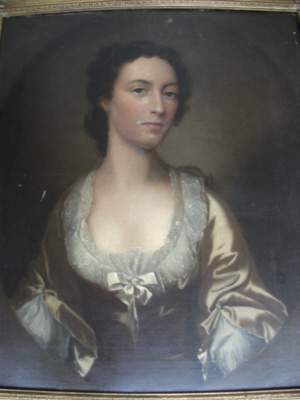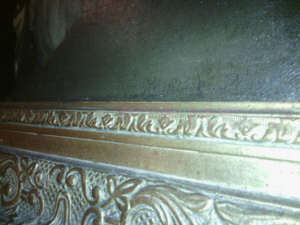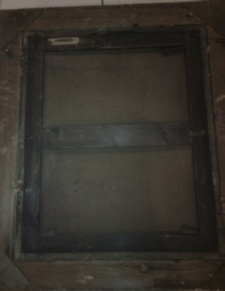
FOUND FLORA MACDONALD PORTRAIT BY ALLAN RAMSAY
On February 16, 2015 I received an email from Mr. Rafael Jorge in Florida pointing to the Laurinburg Exchange and a fascinating
article published on January 28, 2015 by Mr. J.L. Pate, "Portrait could be rare likeness of heroine Flora". After reading it
and realizing that Mr. Jorge the actual owner of the portrait, I immediately contacted him hoping to secure photos to be posted on our
Richmond County NCGenWeb site.
Mr. Jorge writes:
Myrtle, yes I'm the owner of the portrait. I'm the Ex-Vp of a security and investigative company and apply my background in my hobby.
It will be a pleasure to share it with the Richmond County researchers and with the public. I love art and history, very passionate
about it.
I would go as far as to say this painting was brought over by Flora MacDonald from Scotland to North Carolina. But since she left in
bad terms, she might have given it away, sold it or who knows exactly what transpired. I would love to find out more, maybe there is
some documentation that could prove with facts what exactly happened with this historic portrait.
Attached are the pictures for the Richmond County researchers.
Feel free to share information or contact me. Rafael Jorge 786-258-1738
I then contacted Mr. J.L. Pate at the Laurinburg Exchange:
Mr. Pate,
I read with interest your newspaper article, "Portrait could be rare likeness of heroine Flora", after Mr. Rafael Jorge
contacted me yesterday. As the coordinator of the NCGenWeb site for Richmond County, I have collected many articles about Flora
MacDonald which I have posted on the Richmond County internet site. Although I have read much about Flora, even visited the battle
field at Culloden, I certainly am not an expert on her life.
My purpose for contacting you is to obtain permission to post your well-written story about the portrait on the Richmond County
Genealogy Web site.
J.L. Pate's reply:
Yes, by all means. Please feel free to post the Flora MacDonald story on your Richmond County website, provided it includes full
attribution for when and where it originally appeared. Best Wishes, Jim Pate
Contact: Myrtle Bridges
 |
An 18th-century oil portrait believed to be that of Scottish heroine and former
North Carolina resident Flora MacDonald.
PORTRAIT COULD BE RARE LIKENESS OF HEROINE FLORA
Reprinted by permission from the author J.L. Pate, Laurinburg Exchange. Original story dated January 28, 2015
LAURINBURG - An 18th-century oil portrait believed to be that of Scottish heroine and former
North Carolina resident Flora MacDonald, purchased on an educated hunch by a Cuban-born collector
in Florida, may be a find of artistic and historical importance.
Unlike most remaining portraits of MacDonald, this was apparently painted from life, well before
MacDonald gained fame as the woman who helped Prince Charles Edward Stuart escape the Scottish
highlands after his bloody failure to topple the British crown in 1745 and 1746.
The oil painting's estimated value - $250,000, says one appraiser - may owe more to the identity
of the artist than the subject herself, which experts are still debating. Hidden by the frame when
purchased at a small Palm Beach gallery in September, closer scrutiny revealed in small script the
signature "A. Ramsey."
That would be Allan Ramsey, a widely acclaimed 18th-century portrait artist from Edinburg who also
painted a long-lost portrait of Prince Charles made just prior to his ill-fated effort to regain the
crown lost by his Catholic grandfather, James II. Ramsey's larger-than-life portrait of the Duke of
Argyll was later used on Royal Bank of Scotland banknotes. His full-length painting of King George III
is probably the best known of the British monarch who lost the American colonies to revolution.
The owner, Cuban-born entrepreneur Rafael Jorge, contacted The Laurinburg Exchange about the story
via email.
"I knew North Carolina was a major destination for immigrants from Scotland in the 18th century, I knew
Flora MacDonald lived in North Carolina and I was familiar with your newspaper's coverage of Scottish
culture, so I thought you might be interested," Jorge said over the phone from his home in Miramar, FL.
The 38-year-old came to the United States from Cuba in 1989. A successful business career afforded him
the hobby of coin collecting, but he eventually found art to be more "historically relevant."
 |
Hidden by the frame when purchased at a small Palm
Beach gallery in September, closer scrutiny revealed in small script the signature "A. Ramsey."
Jorge, who researched the portrait of the then-unknown subject for several weeks before purchasing
it, was first attracted to the oil painting because of the French style of portraiture, brush techniques
that art historians know influenced Ramsay's work. After trading the gallery owner $1,500 in cash and "
an old coin collection," Jorge took the painting home and soon after discovered the famous signature.
By then, though, he was already fairly sure the portrait is of MacDonald, who lived with her husband in
Cumberland and Anson counties during the Revolutionary War before returning to Scotland.
"This is a striking example of one of Ramsay's portraits of the Scottish Jacobite heroine Flora MacDonald,"
wrote William Bock in an official appraisal of the work. Bock, owner of a fine arts gallery in Davie,
Florida, is a member of the American Society of Appraisers and holds a masters' degree in fine arts.
"Because of the rarity of this younger version of the subject and its importance as an example of Ramsay's
important portraiture, I estimate its value at $250,000," he wrote in a November appraisal.
His appraisal is supported in part by the conclusions of Alan Willis, Mungo Campbell, Colin Harrison and
Phillip Mould, all experts on Ramsay and his work. Harrison is senior curator of the Ashmolean Museum at
Oxford University, which holds many relics from colonial America.
 |
Back of portrait
While the experts are in general agreement that Jorge's painting is from the mid-18th century, and that it was executed
by Allan Ramsay, debate remains about whether the portrait subject is Flora MacDonald.
"Unless you can find some documentary evidence for the identification, you should be cautious," Harrison advised in an e-mail.
"It is always difficult to identify sitters by comparison with other portraits …"
But clues suggest is very well may be Flora MacDonald. For example, the bodice of the portrait's subject is adorned with a
white rose, symbol of Prince Charles and his followers. Although Flora's father was a tacksman - a medieval version of a farm
manager - she was taken in the care of prosperous kinsmen after the death of her father and the abduction of her mother by a
determined suitor.
Finally, her guardians sent her to boarding school in Edinburgh's Old Stamp Office, close to High Street, and adjacent to Castle
Hill, where Allan Ramsay was at the same period painting and living in his father's house.
Jorge said his research will continue while some minor restoration work is done on the canvas. He hopes to sell the work to a
museum or a private buyer, he said. J.L. Pate, Laurinburg Exchange 910-506-3171
 Return to What's New in Richmond County
Return to What's New in Richmond County
 Portrait by Ramsey of Flora MacDonald
Portrait by Ramsey of Flora MacDonald
 Sketches of Distinguished Females
Sketches of Distinguished Females
 The Life and Character of Flora MacDonald by James Banks, Esq. - 1857
The Life and Character of Flora MacDonald by James Banks, Esq. - 1857
 Claim of Allen McDonald of Kingsborough
Claim of Allen McDonald of Kingsborough
 Flora Macdonald - A Romance of the Hebrides
Flora Macdonald - A Romance of the Hebrides
 House Flora Visited
House Flora Visited
 Flora Macdonald Miscellany
Flora Macdonald Miscellany
 Return to Index to Newspapers
Return to Index to Newspapers
 Return to Richmond County Home Page
Copyright February 19, 2015
Return to Richmond County Home Page
Copyright February 19, 2015




Return to What's New in Richmond County
Portrait by Ramsey of Flora MacDonald
Sketches of Distinguished Females
The Life and Character of Flora MacDonald by James Banks, Esq. - 1857
Claim of Allen McDonald of Kingsborough
Flora Macdonald - A Romance of the Hebrides
House Flora Visited
Flora Macdonald Miscellany
Return to Index to Newspapers
Return to Richmond County Home Page Copyright February 19, 2015